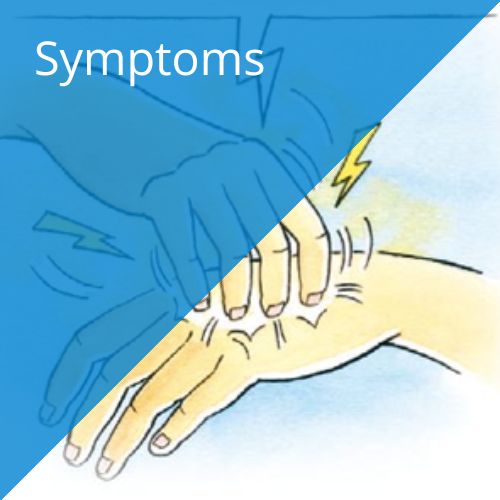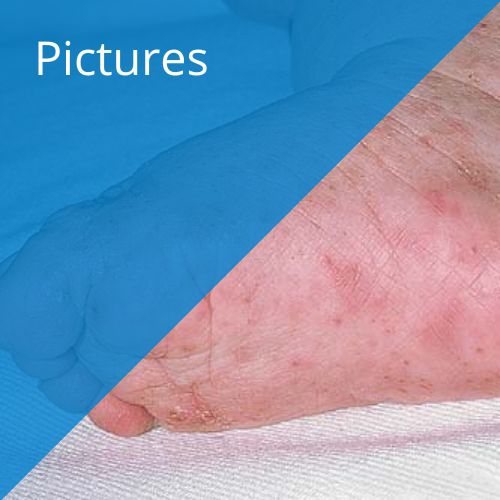Scabies
The Scabies mite is a small animal
closely related to the spider and can barely be seen with the naked eye
Scabies
What is Scabies?
The Scabies mite, Sarcoptes scabiei, is a small animal closely related to spiders that can barely be seen with the naked eye. The aid of a microscope is required to see the scabies mite and the tunnels it digs through the skin.
Scabies are attracted to the human body by body odor and heat. Scabies found among animals thrive best on these carriers, but may nevertheless infect humans. However, this is highly uncommon and results in a less severe form of scabies infection.
The female is 0.4 mm long with a rounded gray-white body. The male is slightly smaller. The female digs tunnels in the epidermis and lays 2-3 eggs a day – a total of 10-25 eggs in her life time. The eggs hatch after 3-4 days and the maggots crawl up on the skin surface to make small pockets in the skin where they develop further. When they are sexually mature, the males mate with the females. After mating the males die and the females dig new paths in the epidermis and begin to lay eggs. Usually only about 15 scabies mites are present on an infected human body. A Scabies infection may persist for a long time since it is generally misdiagnosed because scabies multiply under the skin and are difficult to detect on the body. It may take months and sometimes years before scabies is correctly diagnosed and treated. Since scabies is contagious through direct contact, family members and other people with whom the patient has had close contact are usually also infected.
The most common symptoms of scabies are intense itching and rash from vigorous scratching, which may ultimately develop into eczema in some patients. Scabies mites deposit fecal material, which triggers a hypersensitivity reaction and results in itching and rash. Read more about the symptoms by clicking here.
Individuals with impaired immunity, including older or sick people, are more likely to experience severe symptoms when suffering from scabies. This situation may cause the person to suffer from Norwegian Scabies, also known as crusted Scabies.
How common is scabies?
In recent years, clear trends have shown that more and more cases of scabies have arisen. Outbreaks of scabies have been found primarily in nursing homes and to some extent in hospitals. In addition, more people are seeking treatment at skin clinics after experiencing symptoms that have been shown to be scabies. It has been documented that around 300 million people worldwide are affected by scabies every year. The proportion of affected people is greater in countries where a weakened immune system is more common than in Sweden.
There are various theories that try to explain the reason behind the increase in scabies. One explanation may be that scabies have become more contagious and can spread more easily and cause crusted scabies, also called Norwegian scabies. This form of scabies is starting to become more common in Sweden and affects people with a weakened immune system. There are also theories that explain the increase in scabies through our changed social behavior. Today, teenagers, among others, spend much more time indoors than they did just over 10 years ago. This, combined with the fact that we live closer together today than before, has further increased the risk of infection.
Norwegian scabies
Norwegian scabies, also known as crusted Scabies, is a serious form of scabies infection first discovered in Norway in the mid-nineteenth century. This form of scabies usually afflicts people with impaired immunity, including individuals with AIDS, lymphoma and mental or physical impairments. Norwegian scabies is also common among the elderly since this group generally has a weaker immune system. In Norwegian Scabies, people are infected with hundreds of Scabies mites, compared to a normal infection, where only about 15 Scabies mites are present on the human body. The large number of Scabies mites is due to a compromised immune system which allows the Scabies to multiply drastically. The overwhelming number of Scabies mites on the body means that risk of infection is not limited to family members as in normal Scabies, but also extends to health workers and other people who have any form of body contact with the patient.
In Norwegian Scabies, the primary sites of infection are usually the soles of the feet, knees, elbows, palms and scalp; hands may swell and nails may become discolored. The damage is extensive and may resemble blistering that spreads rapidly. Norwegian Scabies poses a major risk of additional infections, including with Streptococcal bacteria, since the damaged areas of the body are more susceptible to bacterial infection. Intense itching, which is the most common symptom of scabies, does not occur to the same extent in Norwegian Scabies, or may not occur at all in some individuals.
Page last edited 2025-06-13
Treatment information
Tenutex® is a cutaneous emulsion containing benzyl benzoate / disulfiram. Tenutex® is a prescription free medicine that is active against Scabies, Head lice, and Pubic lice. Ask your doctor or nurse before using Tenutex® for treating Pubic lice or Scabies. Treatment of Scabies: Wash and dry your body. Carefully massage the hole body except your head with Tenutex®. Only in infants should the head be treated. Wash off thoroughly after 24 hours. In severe infections, repeat the treatment after 1 week. Avoid contact with the eyes. Tenutex® contains cetostearyl alcohol which may cause local skin reactions (e.g. contact dermatitis). Read the patient information leaflet carefully before use.




